Timeline of the 1998 Atlantic hurricane season
The 1998 Atlantic hurricane season was an event in the annual tropical cyclone season in the north Atlantic Ocean. This Atlantic hurricane season saw an above-average number of named tropical storms,[1][nb 1] and included a single-day record for number of hurricanes simultaneously in progress, with four active on September 25: Georges, Ivan, Jeanne and Karl.[3] The season officially began on June 1, 1998 and ended on November 30, 1998. These dates, adopted by convention, historically describe the period in each year when most tropical systems form.[4] Even so, this season's first storm, Tropical Storm Alex, did not form until July 27, while its last, Hurricane Nicole, dissipated on December 1.
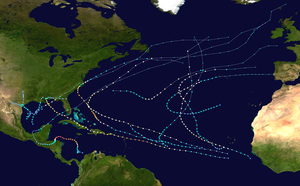
Altogether, 14 tropical storms formed during the season, including 10 hurricanes of which three intensified into major hurricanes.[1][nb 2] Ten of these storms formed during a five week period at the height of the season, August 19 – September 23.[3] The two most significant storms of the season, in terms of loss of life and damage, were hurricanes Georges and Mitch. Georges moved from the Caribbean Sea to the Gulf of Mexico and ultimately to the United States Gulf Coast, resulting extensive damage and a large number of fatalities, especially in Haiti and the Dominican Republic.[1] Mitch formed over the southwestern Caribbean Sea and then moved slowly over Central America, causing catastrophic flooding and leaving more than 11,000 people dead, making it the second deadliest Atlantic hurricane in history after the Great Hurricane of 1780.[6] Following the 1998 season, the names Georges and Mitch were retired from reuse in the North Atlantic by the World Meteorological Organization.[7]
This timeline documents tropical cyclone formations, strengthening, weakening, landfalls, extratropical transitions, and dissipations during the season. It includes information that was not released throughout the season, meaning that data from post-storm reviews by the National Hurricane Center, such as a storm that was not initially warned upon, has been included.
By convention, meteorologists use one time zone when issuing forecasts and making observations: Coordinated Universal Time (UTC), and also use the 24-hour clock (where 00:00 = midnight UTC).[8] In this time line, all information is listed by UTC first with the respective local time included in parentheses.
Timeline

June
June 1
- The 1998 Atlantic hurricane season officially begins.[4]
- No tropical cyclones form in the Atlantic Ocean during the month of June.
July
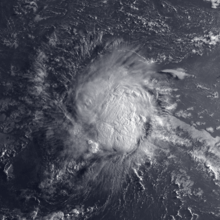
July 27
- 12:00 UTC (8:00 a.m. AST) – Tropical Depression One develops from a tropical wave about 350 miles (560 km) south-southwest of Cape Verde.[9]
July 29
- 00:00 UTC (8:00 p.m. AST, July 28) – Tropical Depression One strengthens and becomes Tropical Storm Alex.[9]
July 31
- 00:00 UTC (8:00 p.m. AST, July 30) – Tropical Storm Alex attains its peak intensity east of the Lesser Antilles with maximum sustained winds of 50 mph (85 km/h) and a minimum barometric pressure of 1,000 mbar (30 inHg).[nb 3][9]
August
August 2
- 18:00 UTC (2:00 p.m. AST) – Tropical Storm Alex weakens to a tropical depression and later dissipates northeast of Saint Martin.[9]
August 19
- 12:00 UTC (8:00 a.m. AST) – Tropical Depression Two develops from a tropical wave while located several hundred miles east of the Leeward Islands.[10]
August 20
- 12:00 UTC (8:00 a.m. AST) – Tropical Depression Two strengthens and becomes Tropical Storm Bonnie about 75 miles (121 km) east of the northern Leeward Islands.[11]
August 21
- 06:00 UTC (1:00 a.m. CDT) – Tropical Depression Three develops in the Gulf of Mexico about 315 miles (505 km) southeast of the south Texas coast.[12]
- 18:00 UTC (1:00 p.m. CDT) – Tropical Depression Three strengthens and becomes Tropical Storm Charley about 210 miles (340 km) east of Brownsville, Texas.[12]
August 22
- 00:00 UTC (8:00 p.m. AST, August 21) – Tropical Storm Bonnie attains Category 1 hurricane strength[10] about 240 mi (385 km) east of Turks Island.[13]
- 06:00 UTC (1:00 a.m. CDT) – Tropical Storm Charley attains its peak intensity with maximum sustained winds of 70 mph (110 km/h) and a minimum barometric pressure of 1,000 mbar (30 inHg).[12]
- 10:00 UTC (5:00 a.m. CDT) – Tropical Storm Charley makes landfall near Port Aransas, Texas with winds of 45 mph (70 km/h).[12]
- 18:00 UTC (2:00 p.m. EDT) – Hurricane Bonnie strengthens to a Category 2 hurricane north-northeast of Turk Island.[10]
- 15:00 UTC (10:00 a.m. CDT) – Tropical Storm Charley weakens to a tropical depression about 45 miles (72 km) north of Alice International Airport Texas),[14] and subsequently dissipates.[12]
August 23
- 12:00 UTC (8:00 a.m. EDT) – Hurricane Bonnie strengthens to a Category 3 hurricane[10] about 180 miles (290 km) east of San Salvador Island, Bahamas.
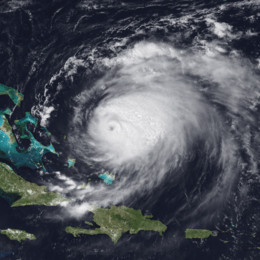
August 24
- 00:00 UTC (8:00 p.m. EDT, August 23) – Hurricane Bonnie attains its peak intensity with maximum sustained winds of 115 mph (185 km/h) and a minimum barometric pressure of 954 mbar (28.2 inHg).[10]
- 06:00 UTC (2:00 a.m. AST) – Tropical Depression Four develops from a tropical wave while located about 600 miles (970 km) west-southwest of Cape Verde.[15]
- 18:00 UTC (2:00 p.m. AST) – Tropical Depression Four strengthens east of the Lesser Antilles and becomes Tropical Storm Danielle.[15]
August 25
- 12:00 UTC (8:00 a.m. AST) – Tropical Storm Danielle strengthens to a Category 1 hurricane.[15]
August 26
- 06:00 UTC (2:00 a.m. AST) – Hurricane Danielle strengthens to a Category 2 hurricane about 1,000 miles (1,600 km) east of the Leeward Islands, and simultaneously attains its maximum sustained wind speed of 105 mph (165 km/h).[15]
- 18:00 UTC (2:00 p.m. AST) – Hurricane Danielle weakens to a Category 1 hurricane.[15]
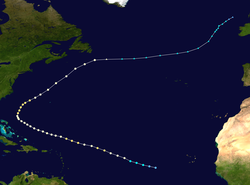
August 27
- 00:00 UTC (8:00 p.m. EDT, August 26) – Hurricane Bonnie weakens to a Category 2 hurricane.[10]
- 04:00 UTC (12:00 a.m. EDT) – Hurricane Bonnie makes landfall near Wilmington, North Carolina with winds of 110 mph (175 km/h).[10]
- 06:00 UTC (2:00 a.m. AST) – Hurricane Danielle restrengthens to a Category 2 hurricane.[15]
- 12:00 UTC (2:00 a.m. AST) – Hurricane Danielle again attains its maximum sustained winds of 105 mph (165 km/h).[15]
- 12:00 UTC (8 a.m. EDT) – Hurricane Bonnie weakens to a Category 1 hurricane over land near New Bern, North Carolina.[10]
- 17:00 UTC (1 p.m. EDT) – Hurricane Bonnie weakens to a tropical storm over land about 70 miles (110 km) south-southeast of Elizabeth City, North Carolina.[16]
August 28
- 00:00 UTC (8:00 p.m. EDT, August 27) – Tropical Storm Bonnie restrengthens to a Category 1 hurricane[10] as it moves off the coast and over the Outer Banks near Manteo, North Carolina.[17]
- 00:00 UTC (8:00 p.m. EDT, August 27) – Hurricane Danielle weakens to a Category 1 hurricane while well to the north of the Leeward Islands.[15]
- 18:00 UTC (2:00 p.m. EDT) – Hurricane Bonnie weakens to a tropical storm[10] about 110 miles (180 km) east-southeast of Wallops Island, Virginia.[18]
August 30
- 18:00 UTC (2:00 p.m. AST) – Tropical Storm Bonnie transitions into an extratropical cyclone south-southeast of Cape Race, Newfoundland and is subsequently absorbed by a front.[10]
August 31
- 12:00 UTC (8:00 a.m. AST) – Hurricane Danielle restrengthens to a Category 2 hurricane and simultaneously attains its maximum sustained wind speed of 105 mph (165 km/h) while northeast of Great Abaco Island, Bahamas.[15]
- 12:00 UTC (7:00 a.m. CDT) – Tropical Depression Five develops from a tropical wave in the Gulf of Mexico roughly halfway between Mérida, Yucatán and Tampico, Tamaulipas.[19]
- 18:00 UTC (1:00 p.m. CDT) – Tropical Depression Five strengthens and becomes Tropical Storm Earl about 580 miles (930 km) south-southwest of New Orleans, Louisiana.[19]
September
September 2
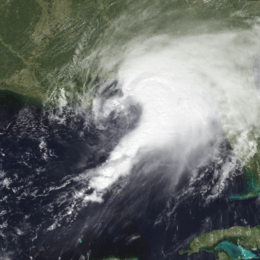
- 06:00 UTC (2:00 a.m. AST) – Hurricane Danielle weakens to a Category 1 hurricane.[15]
- 12:00 UTC (7:00 a.m. CDT) – Tropical Storm Earl strengthens into a Category 1 hurricane about 145 miles (233 km) south-southeast of New Orleans.[19]
- 18:00 UTC (1:00 p.m. CDT) – Hurricane Earl strengthens into a Category 2 hurricane and simultaneously attains its maximum sustained wind speed of 100 mph (155 km/h).[19]
September 3
- 00:00 UTC (7:00 p.m. CDT, September 2) – Hurricane Earl attains its minimum barometric pressure of 985 mbar (29.1 inHg) as it weakens slightly to a Category 1 hurricane.[19]
- 06:00 UTC (1:00 a.m. CDT) – Hurricane Earl makes landfall near Panama City, Florida with winds of 80 mph (130 km/h).[19]
- 06:00 UTC (2:00 a.m. AST) – Hurricane Danielle attains its minimum barometric pressure of 960 mbar (28 inHg).[15]
- 12:00 UTC (7:00 a.m. CDT) – Hurricane Earl weakens to a tropical storm over land[19] about 30 miles (48 km) south of Albany, Georgia.[20]
- 18:00 UTC (1:00 p.m. CDT) – Tropical Storm Earl transitions into an extratropical cyclone over central Georgia, and subsequently, after moving northeastward away from the U.S. southeast coast and then crossing over Newfoundland, is absorbed by the extratropical cyclone that was Hurricane Danielle.[19]
September 4
- 00:00 UTC (8:00 p.m. AST, September 3) – Hurricane Danielle transitions into an extratropical cyclone while centered 230 miles (370 km) south of Cape Race, Newfoundland and subsequently merges with another extratropical low.[15]
September 8
- 18:00 UTC (1:00 p.m. CDT) – Tropical Depression Six develops from a broad area of low pressure while located about 160 miles (260 km) east-southeast of Brownsville, Texas.[21]
September 9
- 18:00 UTC (1:00 p.m. CDT) – Tropical Depression Six strengthens and becomes Tropical Storm Frances.[21]
September 11
- 00:00 UTC (7:00 p.m. CDT, September 10) – Tropical Storm Frances attains its maximum sustained wind speed of 65 mph (100 km/h).[21]
- 06:00 UTC (1:00 a.m. CDT) – Tropical Storm Frances attains its minimum pressure of 994 mbar (29.4 inHg) and simultaneously makes landfall just north of Corpus Christi, Texas with winds of 50 mph (85 km/h).[21]
September 12
- 00:00 UTC (7:00 p.m. CDT, September 11) – Tropical Storm Frances weakens to a tropical depression about 20 miles (32 km) northeast of Victoria, Texas.[22]
September 13
- 18:00 UTC (1:00 p.m. CDT) – Tropical Depression Frances degenerates into a remnant low pressure center over North Texas.[21]
September 15
- 12:00 UTC (8:00 a.m. AST) – Tropical Depression Seven develops from a tropical wave while located about 300 miles (480 km) south-southwest of Cape Verde.[23]
September 16
- 12:00 UTC (8:00 a.m. AST) – Tropical Depression Seven strengthens into Tropical Storm Georges about 710 miles (1,140 km) west-southwest of the Cape Verde Islands.[23]
September 17
- 12:00 UTC (7:00 a.m. CDT) – Tropical Depression Eight develops from a tropical wave while located in the north-central Gulf of Mexico.[24]
- 18:00 UTC (2:00 p.m. AST) – Tropical Storm Georges strengthens into a Category 1 hurricane east of the Lesser Antilles.[23]
September 18
- 12:00 UTC (8:00 a.m. AST) – Hurricane Georges strengthens into a Category 2 hurricane.[23]
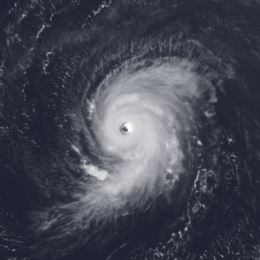
September 19
- 00:00 UTC (8:00 p.m. AST, September 18) – Tropical Depression Nine develops from a tropical wave while located about 200 miles (320 km) southwest of Cape Verde.[25]
- 12:00 UTC (8:00 a.m. AST) – Hurricane Georges strengthens into a Category 3 hurricane about 600 miles (970 km) east of the Lesser Antilles.[26]
- 12:00 UTC (7:00 a.m. CDT) – Tropical Depression Eight strengthens into Tropical Storm Hermine.[24]
- 18:00 UTC (2:00 p.m. AST) – Hurricane Georges strengthens into a Category 4 hurricane.[23]
September 20
- 00:00 UTC (7:00 p.m. CDT, September 19) – Tropical Storm Hermine attains its peak intensity with maximum sustained winds of 45 mph (75 km/h) and a minimum barometric pressure of 999 mbar (29.5 inHg).[24]
- 05:00 UTC (12:00 a.m. CDT) – Tropical Storm Hermine makes landfall near Cocodrie, Louisiana with winds of 40 mph (65 km/h).[24]
- 06:00 UTC (2:00 a.m. AST) – Hurricane Georges attains its peak intensity about 330 miles (530 km) east of Guadeloupe with winds of 155 mph (250 km/h) and a minimum pressure of 937 mbar (27.7 inHg).[23]
- 12:00 UTC (7:00 a.m. CDT) – Tropical Storm Hermine weakens to a tropical depression about 50 miles (80 km) northwest of New Orleans, Louisiana.[27]
- 18:00 UTC (2:00 p.m. AST) – Tropical Depression Nine strengthens into Tropical Storm Ivan west of the Cape Verde Islands.[25]
- 18:00 UTC (1:00 p.m. CDT) – Tropical Depression Hermine dissipates over southeastern Mississippi.[24]
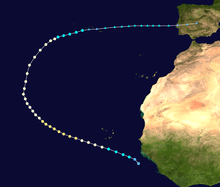
September 21
- 00:00 UTC (8:00 p.m. AST, September 20) – Hurricane Georges weakens to a Category 3 hurricane about 85 miles (137 km) east-southeast of Antigua.[28]
- 04:00 UTC (12:00 a.m. AST) – Hurricane Georges makes landfall near Falmouth, Antigua with winds of 115 mph (185 km/h).[23]
- 06:00 UTC (2:00 p.m. AST) – Tropical Depression Ten develops from a tropical wave while located about 160 miles (260 km) southwest of the coast of Guinea-Bissau.[29]
- 08:00 UTC (4:00 a.m. AST) – Hurricane Georges makes landfall near Basseterre, St. Kitts with winds of 115 mph (185 km/h).[23]
- 18:00 UTC (2:00 p.m. AST) – Tropical Depression Ten strengthens into Tropical Storm Jeanne.[29]
- 22:00 UTC (6:00 p.m. AST) – Hurricane Georges makes landfall near Fajardo, Puerto Rico with winds of 115 mph (185 km/h).[23]
September 22
- 05:00 UTC (1:00 a.m. AST) – Hurricane Georges moves off shore over Mona Passage about 25 miles (40 km) west-southwest of Mayagüez, Puerto Rico as a Category 2 hurricane.[30]
- 12:30 UTC (8:30 a.m. AST) – Hurricane Georges restrengthens to a Category 3 hurricane and makes landfall about 85 miles (137 km) east of Santo Domingo, Dominican Republic with winds of 120 mph (195 km/h).[23]
- 18:00 UTC (2:00 p.m. AST) – Hurricane Georges weakens to a Category 2 hurricane over land just north of Santo Domingo.[23]
- 18:00 UTC (2:00 p.m. AST) – Tropical Storm Jeanne strengthens into a Category 1 hurricane about 140 miles (230 km) southwest of the Cape Verde Islands.[29]
September 23
- 09:00 UTC (5:00 a.m. EDT) – Hurricane Georges emerges over the waters of the Windward Passage west of Gonaïves, Haiti as a Category 1 hurricane.[31]
- 12:00 UTC (8:00 a.m. AST) – Tropical Depression Eleven develops from a low pressure area while located about 55 miles (89 km) west-northwest of Bermuda.[32]
- 18:00 UTC (2:00 p.m. AST) – Tropical Storm Ivan strengthens into a Category 1 hurricane southwest of the Azores.[25]
- 18:00 UTC (2:00 p.m. AST) – Hurricane Jeanne strengthens into a Category 2 hurricane west of the Cape Verde Islands..[29]
- 21:30 UTC (5:30 p.m. AST) – Hurricane Georges makes landfall about 30 miles (48 km) east of Guantanamo Bay, Cuba with winds of 75 mph (120 km/h).[23]
September 24
- 00:00 UTC (8:00 p.m. AST, September 23) – Tropical Depression Eleven strengthens into Tropical Storm Karl northeast of Bermuda.[32]
- 18:00 UTC (2:00 p.m. EDT) – Hurricane Georges emerges into the Straits of Florida near Cayo Coco along the north coast of Cuba as a Category 1 hurricane.[33]
- 18:00 UTC (2:00 p.m. AST) – Hurricane Jeanne attains its peak intensity 670 miles (1,080 km) west of the westernmost Cape Verde Islands with maximum sustained winds of 105 mph (170 km/h) and a minimum barometric pressure of 969 mbar (28.6 inHg).[29]
September 25
- 06:00 UTC (2:00 a.m. EDT) – Hurricane Georges restrengthens to a Category 2 hurricane southeast of Key West, Florida.[23]
- 12:00 UTC (2:00 p.m. AST) – Tropical Storm Karl strengthens into a Category 1 hurricane west-southwest of the Azores.[32]
- 15:30 UTC (11:30 a.m. EDT) – Hurricane Georges makes landfall on Key West with winds of 105 mph (165 km/h).[23]
- 18:00 UTC (2:00 p.m. AST) – Hurricane Jeanne weakens to a Category 1 hurricane west of the Cape Verde Islands.[29]
September 26
- 06:00 UTC (2:00 a.m. AST) – Hurricane Ivan attains its peak intensity about 350 miles (560 km) west of the Azores Islands with maximum sustained winds of 90 mph (150 km/h) and a minimum barometric pressure of 975 mbar (28.8 inHg).[25]
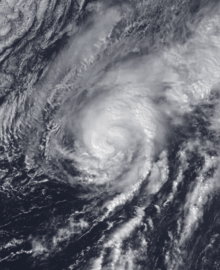
September 27
- 00:00 UTC (8:00 p.m. AST, September 26) – Hurricane Ivan weakens to a tropical storm northwest of Lajes, Azores Islands.[25]
- 00:00 UTC (8:00 p.m. AST, September 26) – Hurricane Karl strengthens into a Category 2 hurricane and simultaneously attains its peak intensity about 1,005 miles (1,617 km) east-northeast of Bermuda with maximum sustained winds of 105 mph (170 km/h) and a minimum barometric pressure of 970 mbar (29 inHg).[32]
- 06:00 UTC (2:00 a.m. AST) – Tropical Storm Ivan transitions into an extratropical cyclone north of the Azores.[25]
- 12:00 UTC (2:00 p.m. AST) – Hurricane Karl weakens to a Category 1 hurricane west of the Azores.[32]
September 28
- 00:00 UTC (8:00 p.m. AST, September 27) – Hurricane Karl weakens to a tropical storm 200 miles (320 km) west-northwest of the Western Azores.[32]
- 06:00 UTC (2 a.m. AST) – Tropical Storm Karl transitions into an extratropical cyclone.[32]
- 11:30 UTC (6:30 a.m. CDT) – Hurricane Georges makes landfall in Biloxi, Mississippi with winds of 105 mph (165 km/h).[23]
- 18:00 UTC (1 p.m. CDT) – Hurricane Georges weakens to a Category 1 hurricane just north of Biloxi.[23]
September 29
- 00:00 UTC (7:00 p.m. CDT, September 28) – Hurricane Georges weakens to a tropical storm about 20 miles (32 km) north of Biloxi.[34]
- 12:00 UTC (7:00 a.m. CDT) – Tropical Storm Georges weakens to a tropical depression about 35 miles (56 km) north-northeast of Mobile, Alabama.[23]
- 18:00 UTC (2:00 p.m. AST) – Hurricane Jeanne weakens to a tropical storm west-southwest of the Azores.[29]
September 30
- 21:00 UTC (5:00 p.m. AST) – Tropical Storm Jeanne weakens to a tropical depression about 25 miles (40 km) south of Horta, Azores.[35]
October
October 1
- 0600 UTC (2:00 a.m. AST) – Tropical Depression Jeanne transitions into an extratropical cyclone east of the Central Azores and subsequently dissipates.[29]
- 12:00 UTC (8:00 a.m. EDT) – Tropical Depression Georges dissipates over the Atlantic coast near Jacksonville, Florida.[23]
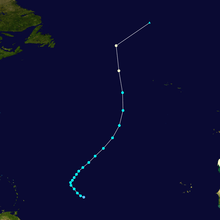
October 5
- 00:00 UTC (8:00 p.m. AST, October 4) – Tropical Depression Twelve develops from a tropical wave while located about halfway between Cape Verde and the Lesser Antilles.[36]
- 06:00 UTC (2:00 a.m. AST) – Tropical Depression Twelve strengthens into Tropical Storm Lisa.[36]
October 9
- 12:00 UTC (8:00 a.m. AST) – Tropical Storm Lisa strengthens into a Category 1 hurricane and simultaneously attains its peak intensity with maximum sustained winds of 75 mph (120 km/h) and a minimum barometric pressure of 995 mbar (29.4 inHg).[36]
- 21:00 UTC (5:00 p.m. AST) – Hurricane Lisa becoming extratropical about 900 miles (1,400 km) northwest of the Western Azores,[37] and later merges with an extratropical frontal system.[36]
October 22
- 00:00 UTC (8:00 p.m. EDT, October 21) – Tropical Depression Thirteen develops from a tropical wave while located about 415 miles (660 km) south of Kingston, Jamaica.[38]
- 18:00 UTC (2:00 p.m. EDT) – Tropical Depression Thirteen strengthens and becomes Tropical Storm Mitch about 260 miles (420 km) east-southeast of San Andrés Island, Colombia.[38]
October 24
- 06:00 UTC (2:00 a.m. EDT) – Tropical Storm Mitch strengthens into a Category 1 hurricane about 295 miles (475 km) south-southwest of Kingston, Jamacia.[38]
- 18:00 UTC (2:00 p.m. EDT) – Hurricane Mitch strengthens into a Category 2 hurricane about 215 miles (345 km) south-southwest of Kingston.[39]
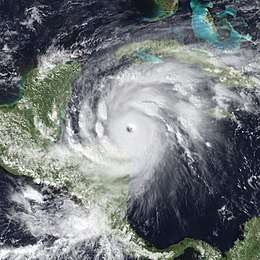
October 25
- 00:00 UTC (8:00 p.m. EDT, October 24) – Hurricane Mitch strengthens into a Category 3 hurricane.[38]
- 12:00 UTC (7:00 a.m. EST)[nb 4] – Hurricane Mitch strengthens into a Category 4 hurricane.[38]
October 26
- 12:00 UTC (7:00 a.m. EST) – Hurricane Mitch strengthens into a Category 5 hurricane.[38]
- 18:00 UTC (1:00 p.m. EST) – Hurricane Mitch attains its peak intensity about 60 miles (97 km) southeast of Great Swan Island, Honduras, with sustained winds of 180 mph (285 km/h) and a minimum pressure of 905 mbar (26.7 inHg).[38]
October 28
- 06:00 UTC (1:00 a.m. EST) – Hurricane Mitch weakens to a Category 4 hurricane very near the island of Guanaja and about 35 miles (55 km) north of the coast of mainland Honduras.[40]
- 12:00 UTC (7:00 a.m. EST) – Hurricane Mitch weakens to a Category 3 hurricane while meandering east-southeast of Guanaja.[41]
October 29
- 00:00 UTC (7:00 p.m. EST, October 28) – Hurricane Mitch weakens to a Category 2 hurricane about 25 miles (40 km) east of the island of Roatán and about 25 miles (40 km) north of the coast of Honduras.[42]
- 06:00 UTC (1:00 a.m. EST) – Hurricane Mitch weakens to a Category 1 hurricane while remaining virtually stationary east of Roatán.[43]
- 12:00 UTC (7:00 a.m. EST) – Hurricane Mitch makes landfall on the mainland coast of Honduras about 85 miles (137 km) east of La Ceiba with sustained winds of 80 mph (130 km/h).[38]
- 18:00 UTC (1:00 p.m. EST) – Hurricane Mitch weakens to a tropical storm along the coast near Limón.[38]
October 31
- 15:00 UTC (9:00 a.m. CST) – Tropical Storm Mitch weakens to a tropical depression inland about 25 miles (40 km) south of Santa Rosa de Copán, Honduras.[44]
November
November 1
- 21:00 UTC (3:00 p.m. CST, November 1) – Tropical Depression Mitch dissipates into an area of low pressure near Tapachula, Chiapas along the Guatemala–Mexico border.[45]
November 3
- 18:00 UTC (12:00 p.m. CST) – The area of low pressure re-generatee into Tropical Storm Mitch after emerging into the Bay of Campeche.[38]
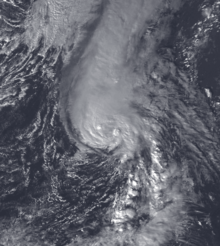
November 4
- 02:00 UTC (8:00 p.m. CST, November 3) – Tropical Storm Mitch makes landfall about 15 miles (24 km) north-northeast of Campeche, Campeche with winds of 40 mph (65 km/h).[38]
- 06:00 UTC (12:00 a.m. CST) – Tropical Storm Mitch weakens to a tropical depression over the Yucatán Peninsula.[38]
- 12:00 UTC (6:00 a.m. CST) – Tropical Depression Mitch re-strengthens into a tropical storm after emerging into the Gulf of Mexico.[38]
November 5
- 11:00 UTC (6:00 a.m. EST) – Tropical Storm Mitch makes landfall about 5 miles (8.0 km) west of Naples, Florida with winds of 65 mph (100 km/h).[38]
- 15:00 UTC (10:00 a.m. EST) – Tropical Storm Mitch nears the east coast of Florida just north of Jupiter.[46]
- 18:00 UTC (1:00 p.m. EST) – Tropical Storm Mitch transitions into an extratropical cyclone about 100 miles (160 km) north of Grand Bahama Island, Bahamas.[38]
November 24
- 00:00 UTC (8:00 p.m. AST, November 23) – Tropical Depression Fourteen develops from a strong frontal low pressure area near the Canary Islands.[47]
- 06:00 UTC (2:00 a.m. AST) – Tropical Depression Fourteen strengthens into Tropical Storm Nicole.[47]
November 26
- 09:00 UTC (5:00 a.m. AST) – Tropical Storm Nicole weakens to a tropical depression about 1,200 miles (1,900 km) west-southwest of La Palma, Canary Islands.[48]
November 27
- 18:00 UTC (2:00 p.m. AST) – Tropical Depression Nicole re-strengthens into a tropical storm about 1,540 miles (2,480 km) west-southwest of the Canary Islands.[47]
November 30
- 00:00 UTC (8:00 p.m. AST, November 29) – Tropical Storm Nicole strengthens into a Category 1 hurricane southwest of the Azores.[47]
- The 1998 Atlantic hurricane season officially ends.[4]
December
December 1
- 00:00 UTC (8:00 p.m. AST, November 30) – Hurricane Nicole attains its peak intensity with maximum sustained winds of 85 mph (140 km/h) and a minimum barometric pressure of 979 mbar (28.9 inHg).[47]
- 12:00 UTC (8:00 a.m. AST) – Hurricane Nicole weakens to a tropical storm.[47]
- 18:00 UTC (2:00 p.m. AST) – Tropical Storm Nicole transitions into an extratropical cyclone northwest of the Azores.[47]
See also
Notes
- An average Atlantic hurricane season, as defined by the National Oceanic and Atmospheric Administration, has 12 tropical storms, six hurricanes and two major hurricanes.[2]
- Hurricanes reaching Category 3 (111 miles per hour (179 km/h)) and higher on the 5-level Saffir–Simpson wind speed scale are considered major hurricanes.[5]
- The figures for maximum sustained winds and position estimates are rounded to the nearest 5 units (knots, miles, or kilometers), following the convention used in the National Hurricane Center's operational products for each storm. All other units are rounded to the nearest digit.
- Daylight saving time ended on October 25, 1998. At 2:00 a.m. EDT clocks were moved back to 1:00 a.m. EST.
References
- Dolce, Chris (June 12, 2018). "Top-10 Most Extreme Atlantic Hurricane Seasons in the Satellite Era". weather.com. Atlanta, Georgia: The Weather Channel. Retrieved August 6, 2020.
- "Background Information: North Atlantic Hurricane Season". College Park, Maryland: NOAA Climate Prediction Center. Retrieved August 6, 2020.
- "1998 Hurricane Activity for the North Atlantic, Caribbean Sea and Gulf of Mexico". NOAA/National Weather Service, NOAA/National Centers for Environmental Prediction. November 30, 1998. Retrieved August 6, 2020.
- Dorst, Neal (June 1, 2018). "Hurricane Season Information". Frequently Asked Questions About Hurricanes. Miami, Florida: NOAA Atlantic Oceanographic and Meteorological Laboratory. Retrieved August 6, 2020.
- "Saffir-Simpson Hurricane Wind Scale". Miami, Florida: National Hurricane Center. Retrieved August 6, 2020.
- "Great Hurricane of 1780". history.com. A&E Television Networks. April 12, 2019 [December 2, 2009]. Retrieved August 6, 2020.
- "Tropical Cyclone Naming History and Retired Names". miami, Florida: NOAA National Hurricane Center. Retrieved August 6, 2020.
- "Understanding the Date/Time Stamps". miami, Florida: NOAA National Hurricane Center. Retrieved August 6, 2020.
- Guiney, John L. (December 22, 1998). Preliminary Report Tropical Storm Alex (PDF) (Report). Miami, Florida: National Hurricane Center. Retrieved August 4, 2020.
- Avila, Lixion A. (October 24, 1998). Preliminary Report Hurricane Bonnie (PDF) (Report). Miami, Florida: National Hurricane Center. Retrieved August 4, 2020.
- Pasch, Richard J. (August 20, 1998). Tropical Storm Bonnie Advisory Number 5 (Report). Miami, Florida: National Weather Service. Retrieved August 6, 2020.
- Rappaport, Edward N. (October 23, 1998). Preliminary Report Tropical Storm Charley (PDF) (Report). Miami, Florida: National Hurricane Center. Retrieved August 4, 2020.
- Mayfield, Max (August 21, 1998). Tropical Storm Bonnie Intermediate Advisory Number 9A (Report). Miami, Florida: National Weather Service. Retrieved August 6, 2020.
- Lawrence, Miles B. (August 22, 1998). Tropical Depression Charley Advisory Number 5 (Report). Miami, Florida: National Weather Service. Retrieved August 6, 2020.
- Pasch, Richard J. (January 19, 1999). Preliminary Report Hurricane Danielle (PDF) (Report). Miami, Florida: National Hurricane Center. Retrieved August 4, 2020.
- Rappaport, Edward N. (August 27, 1998). Tropical Storm Bonnie Intermediate Advisory Number 35A (Report). Miami, Florida: National Weather Service. Retrieved August 10, 2020.
- Mayfield, Max (August 27, 1998). Tropical Storm Bonnie Intermediate Advisory Number 36A (Report). Miami, Florida: National Weather Service. Retrieved August 10, 2020.
- Jarvinen, Brian R. (August 28, 1998). Tropical Storm Bonnie Intermediate Advisory Number 39A (Report). Miami, Florida: National Weather Service. Retrieved August 10, 2020.
- Mayfield, Max (November 17, 1998). Preliminary Report Hurricane Earl (PDF) (Report). Miami, Florida: National Hurricane Center. Retrieved August 10, 2020.
- Rappaport, Edward N. (September 3, 1998). Hurricane Earl Intermediate Advisory Number 12A (Report). Miami, Florida: National Weather Service. Retrieved August 10, 2020.
- Lawrence, Miles B. (November 18, 1998). Preliminary Report Tropical Storm Frances (PDF) (Report). Miami, Florida: National Hurricane Center. Retrieved August 10, 2020.
- Avila, Lixion A. (September 11, 1998). Tropical Depression Frances Intermediate Advisory Number 13A (Report). Miami, Florida: National Weather Service. Retrieved August 10, 2020.
- Guiney, John L. (January 5, 1999) [Updated September 9, 2014]. Preliminary Report Hurricane Georges (PDF) (Report). Miami, Florida: National Hurricane Center. Retrieved August 10, 2020.
- Avila, Lixon A. (November 9, 1998). Preliminary Report Tropical Storm Hermine (PDF) (Report). Miami, Florida: National Hurricane Center. Retrieved August 10, 2020.
- Rappaport, Edward N. (November 18, 1998). Preliminary Report Hurricane Ivan (PDF) (Report). Miami, Florida: National Hurricane Center. Retrieved August 10, 2020.
- Avila, Lixion A. (September 19, 1998). Hurricane Georges Intermediate Advisory Number 16A (Report). Miami, Florida: National Weather Service. Retrieved August 10, 2020.
- Jarvinen, Brian R. (September 20, 1998). Tropical Depression Hermine Intermediate Advisory Number 11A (Report). Miami, Florida: National Weather Service. Retrieved August 10, 2020.
- Guiney, John L. (September 20, 1998). Hurricane Georges Intermediate Advisory Number 22A (Report). Miami, Florida: National Weather Service. Retrieved August 10, 2020.
- Pasch, Richard J. (February 8, 1999). Preliminary Report Hurricane Jeanne (PDF) (Report). Miami, Florida: National Hurricane Center. Retrieved August 10, 2020.
- Lawrence, Miles B. (September 22, 1998). Hurricane Georges Intermediate Advisory Number 27A (Report). Miami, Florida: National Weather Service. Retrieved August 10, 2020.
- Lawrence, Miles B. (September 23, 1998). Hurricane Georges Intermediate Advisory Number 32 (Report). Miami, Florida: National Weather Service. Retrieved August 10, 2020.
- Mayfield, Max (November 16, 1998). Preliminary Report Hurricane Karl (PDF) (Report). Miami, Florida: National Hurricane Center. Retrieved August 10, 2020.
- Avila, Lixion A. (September 24, 1998). Hurricane Georges Intermediate Advisory Number 37A (Report). Miami, Florida: National Weather Service. Retrieved August 10, 2020.
- Lawrence, Miles B. (September 28, 1998). Tropical Storm Georges Intermediate Advisory Number 54A (Report). Miami, Florida: National Weather Service. Retrieved August 10, 2020.
- Pasch, Richard J. (September 30, 1998). Tropical Depression Jeanne Advisory Number 37 (Report). Miami, Florida: National Weather Service. Retrieved August 10, 2020.
- Lawrence, Miles B. (December 4, 1998). Preliminary Report Hurricane Lisa (PDF) (Report). Miami, Florida: =National Hurricane Center. Retrieved August 10, 2020.
- Avila, Lixion A. (October 9, 1998). Hurricane Lisa Advisory Number 17 (Report). Miami, Florida: National Weather Service. Retrieved August 10, 2020.
- Guiney, John L.; Lawrence, Miles B. (January 28, 1999) [Revised May 4, 2000]. Preliminary Report Hurricane Mitch (PDF) (Report). Miami, Florida: National Hurricane Center. Retrieved August 10, 2020.
- Avila, Lixion A. (October 24, 1998). Hurricane Mitch Intermediate Advisory Number 11A (Report). Miami, Florida: National Weather Service. Retrieved August 10, 2020.
- Guiney, John L. (October 28, 1998). Hurricane Mitch Intermediate Advisory Number 26A (Report). Miami, Florida: National Weather Service. Retrieved August 10, 2020.
- Guiney, John L. (October 28, 1998). Hurricane Mitch Intermediate Advisory Number 27A (Report). Miami, Florida: National Weather Service. Retrieved August 10, 2020.
- Pasch, Richard J. (October 28, 1998). Hurricane Mitch Intermediate Advisory Number 29A (Report). Miami, Florida: National Weather Service. Retrieved August 10, 2020.
- Guiney, John L. (October 29, 1998). Hurricane Mitch Intermediate Advisory Number 30A (Report). Miami, Florida: National Weather Service. Retrieved August 10, 2020.
- Guiney, John L. (October 31, 1998). Tropical Depression Mitch Advisory Number 40 (Report). Miami, Florida: National Weather Service. Retrieved August 10, 2020.
- Pasch, Richard J. (November 1, 1998). Tropical Depression Mitch Advisory Number 45 (Report). Miami, Florida: National Weather Service. Retrieved August 10, 2020.
- Rappaport, Edward N. (November 5, 1998). Tropical Depression Mitch Advisory Number 53 (Report). Miami, Florida: National Weather Service. Retrieved August 10, 2020.
- Avila, Lixion A. (December 17, 1998). Preliminary Report Hurricane Nicole (PDF) (Report). Miami, Florida: National Hurricane Center. Retrieved August 10, 2020.
- Pasch, Richard J. (November 26, 1998). Tropical Depression Nicole Advisory Number 9 (Report). Miami, Florida: National Weather Service. Retrieved August 10, 2020.
Further reading
- Pasch, Richard J.; Avila, Lixion A.; Guiney, John L. (December 2001). "Atlantic Hurricane Season of 1998". Monthly Weather Review. American Meteorological Society. 129 (12): 3085–3123.
External links
| Wikimedia Commons has media related to 1998 Atlantic hurricane season. |